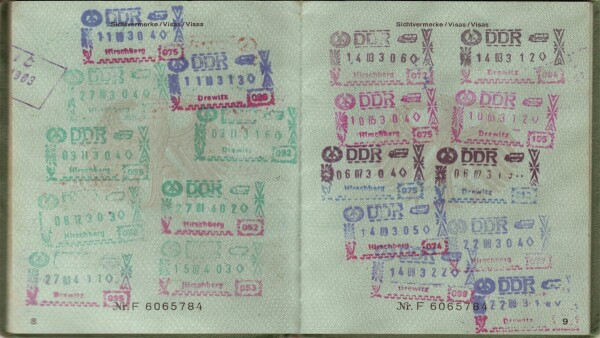How to apply for a Vietnamese visa
This is the ultimate guide to getting a tourist Visa to Vietnam; from visa exemption to visas on arrival, e-visas, and more.

Vietnam is a country with an abundance of stunning landscapes to explore and a beautiful culture to get to know. It’s not yet popular for travel, often overshadowed by Thailand. Just as amazing, if not more, it should definitely be on your travel bucket list.
When it comes to visiting Vietnam, most nationalities will need a visa to enter and only a few are exempt. Visas can be obtained in numerous ways and the purpose of this article is to give you enough information so you can have a hassle-free entrance to the country.
Are you exempt from a visa altogether?
Some nationalities are completely visa-exempt for up to 90 days due to exemption agreements made between them and the Vietnamese government.
| Citizens of: | Days of visa-free entry: |
| Brunei & Myanmar | 14 days |
| United Kingdom*, France*, Italy*, Spain*, Germany*, Belarus*, Japan, South Korea, Sweden, Norway, Denmark, Russia, Finland | 30 days |
| Cambodia, Thailand, Malaysia, Singapore, Indonesia, Laos | 30 days |
| The Philippines | 21 days |
| Chile | 90 days |
* Granted visa exemption only until June 30th, 2021.
Source: Vietnam Immigration
If you’re from any of these countries, then all you have to present to the immigration is your passport and return ticket. Lucky you.
If during your travels you fall in love with Vietnam and wish to stay longer, you are able to renew your visa at any of the main immigration departments located in either Hanoi, Ho Chi Minh City, or Da Nang. Citizens from Japan, South Korea, Denmark, Russia, Sweden, Norway, Finland, UK, France, Germany, Italy, Spain are able to re-enter under the visa waiver again, but must wait at least 30 days from the exit date to be able to do so.
Getting a tourist visa is not difficult

No matter where you’re from, you’ll be able to visit Vietnam and see all the wonders that the country has to offer, from Hanoi to Sapa, Da Lat to Ho Chi Minh City, and everywhere in between. However, some nationalities just have to take an extra step or two. For tourist visas, you have the option of applying for a 1-month or 3-month option, which may be further extended/renewed after your arrival in Vietnam. These visas come in the single or multiple entry types and prices change accordingly. Other factors also affect the price, such as your nationality, location of application, and duration of stay.
The required documents for your application also vary depending on many factors. Generally, you have to provide your passport, flight tickets (including return), hotel bookings, two recent photos, a filled out visa application form, and of course, cash. However it is best to call the Vietnamese embassy nearest you, present your information, and then ask them to provide their most up to date requirements. Check out this website to get country-specific information about what documents you should provide. Here’s a list of Vietnamese embassies and consulates around the world.
It takes about three to seven business days to complete your application. This could be longer if there is no Vietnamese embassy or consulate in your city, which means you will have to DHL your passport over.
A visa on arrival is even easier
Some nationalities are eligible to get Visa on Arrival (VOA). This entails arranging a visa approval letter through an agency. These agencies are authorized by the Vietnamese government to collect passport details and arrange for an approval letter. You can apply for the standard tourist visas and to do so, just scan and send over the relevant documents and pay the small fee online. To speed up the process, you can pay extra.
VOA only works for those flying into the country via Hanoi, Ho Chi Minh, Da Nang, Nha Trang, Da Lat, Hai Phong, or Phu Quoc airports. Just present your passport, the printed out letter, a filled out visa application form, and two recent pictures. Your passport must be valid for at least another month from the date of exit and have at least two empty pages. The stamping fee depends on the type of visa you opted for and your nationality, and can range from $25 USD to over $100 USD. Once your passport is stamped, you’re good to go.
Important note – VOA is not an option if you are arriving in Vietnam via land border.
For eligibility and instructions, you may check VOAVietnam, a trusted visa agency. Be wary when you use other websites, as often there are scams online.
Sometimes all you need is a PDF – e-visa

An e-Visa is a type of electronic travel authorization granted from the Vietnam government. These are valid for a single entry only and allows you to remain in the country for up to 30 days. For a list of countries that can apply for e-Visa, and more details about your application, click here. You can apply at the same link.
To apply, you have to upload your passport data page and photo. You will receive a registration code and once you do, you will be taken to a payment page. That’s pretty much it. You will be able to track your e-Visa status online, and when it is approved, you will be sent the visa in PDF format. However, keep in mind that if your application is rejected, you will not be refunded.
Once you receive your visa, all you have to do is print it out/show it on your phone at the immigration along with your passport. Just like for VOA, the passport must be valid for at least one month after arrival and have two blank pages.
Once you’re stamped, pick up your baggage if you have any, and exit onto the beautiful organized chaos that awaits.
But…what if I want to stay longer???
Simple. Kind of. You have three potential solutions to your problem – either extend or renew your visa, or exit and apply for a brand new one.
1. Extending your visa
You can extend your visa by either heading to the Vietnam Immigration Department in any of the major cities, or via online agents that help simplify the process for you. Extension is only possible for a period of 1 or 3 months, and this depends on the visa you currently have. Documents you need to submit include copies of your passport bio page, current visa, immigration stamp, last date of entry, port of entry and details of your current address in Vietnam. The whole process can cost you upwards of $200 USD – certainly not a light fee.
2. Renewing your visa
Visa renewal is quite similar to extension in the sense that you are only allowed to renew for a maximum period of 3 months and it will cost you about the same. The difference here is that you are granted a whole new visa sticker and stamp on your passport, and the renewal option is available for those who initially entered Vietnam with visa exemption!
Unfortunately, only a limited number of nationalities are eligible to apply for a visa extension/renewal, and the requirements and prices change accordingly as well. You can contact the immigration department in advance and find out the information relevant to you.
Vietnam Immigration Department (A18) in Hanoi:
Address: 44- 46 Tran Phu Street, Ba Dinh District, Ha Noi
Phone numbers:
+84 43 826 4026: About entry and exit Vietnam, residing of foreigners in Vietnam, repatriating of Vietnam citizens living abroad
+84 43 934 5609: Administration procedures
+84 43 825 7941: about entry and exit at Vietnam borders and other related issues
Vietnam Immigration Department (A18) in Da Nang
Address: 80 Le Loi, Hai Chau, Da Nang
Telephone: +84 236 3860 191
Vietnam Immigration Department (A18) in Ho Chi Minh City
Address: 337 Nguyen Trai, Nguyen Cu Trinh Ward, District 1, Ho Chi Minh City
Telephone: +84 838 299 398
3. Exit and enter again
To avoid all the hassle and paying high amounts for a visa extension or renewal, it may be a better idea to do a visa run and reapply for a new one instead. You can follow a similar application method as mentioned above and apply through Vietnamese consulates abroad or online agencies. You have many options to do your “visa run” such as Cambodia or Laos by bus, and Thailand with a quick 2 hour flight. But make sure you check into the visa policies of these countries too!
Don’t miss your exit!
If you overstay your visa, just like in any other country, you will have to pay penalty fees. There are two fees you will have to shell out for – one is the “fine” fee, and the second is either the extension fee (if you want to stay) or exit fee (if you want to or are forced to leave). The fees change based on how long you have overstayed your visa by – but expect to pay about 500,000 VND ($25 USD) per day. The longer you overstay, the more complicated things get as well and unfortunately you may be blacklisted and not get the chance to return to Vietnam and experience its beauty one more time. Avoiding these issues are simple, just pay attention to your visa validity and plan your exit in time.






